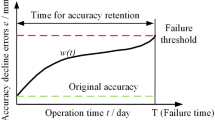Abstract
Nowadays, the demand for high-quality enveloping surface parts is increasing in machinery, aviation, military, and many other fields. Given the complexity of the surfaces, the enveloping surfaces parts are usually processed by grinding method. This grinding process is low in precision and poor in efficiency for lack of accurate digital CAD model of these parts. In this paper, a new modeling method for the complicated enveloping parts has been developed. The digital CAD model is constructed by using vector representation, transformation matrix, and spatial meshing theory. Next, a better computerized numerical control (CNC) machining code is generated based on the accurate digital CAD model, and a high-quality envelope surface could be machined on the basis of the code in CNC machining center. The normal vector algorithm is adopted to detect and avoid collision and interference during the processing. Finally, the digital CAD models of a planar double-enveloping worm and worm wheel famous at difficulty in modeling and CNC machining have been conducted as an instance. The machining experiment results show that the machining precision of the enveloping surface parts have been increased because the part’s digital CAD model is extraordinarily accurate.
Similar content being viewed by others
References
Cao YH, Li GZ, Hess RA (2012) Helicopter flight characteristics in icing conditions. Aeronaut J 116(1183):963–979
Chryssolouris G (2009) Digital manufacturing: history, perspectives, and outlook. Proc Inst Mech Eng B J Eng Manuf 223(5):451–462
Berbinschi S, Teodor V, Oancea N (2012) 3D graphical method for profiling tools that generate helical surface. Int J Adv Manuf Technol 60(5–8):505–512
Berbinschi S, Teodor V, Oancea N (2013) 3D graphical method for profiling gear hob tools. Int J Adv Manuf Technol 64(1–4):291–304
Falah AH, Elkholy AH (2008) Load sharing and stress analysis of single enveloping worm gearing considering transmission errors. Int J Adv Manuf Technol 37(3–4):211–220
Sharif KJ, Evans HP, Snidle RW, Barnett D, Egorov IM (2006) Effect of elastohydrodynamic film thickness on a wear model for worm gears. J Eng Tribol 220(J3):295–306
Berbinschi S, Teodor V, Oancea N (2012) A study on helical surface generated by the primary peripheral surfaces of ring tool. Int J Adv Manuf Technol 61(1–4):15–24
Li CG, Bedi S, Mann S (2012) NURBS approximation to the flank-milled surface swept by a cylindrical NC tool. Int J Adv Manuf Technol 61(1–4):35–51
Kuan YC, Chung BT (2009) Mathematicla model and worm wheel tooth working surfaces of the ZN-type hourglass worm gear set. Mech Mach Theory 44:1701–1712
Simon V (2007) The influence of gear hobbing on worm gear characteristics. J Manuf Sci Eng Trans ASME 129(5):919–925
Litvin FL, Gonzalez-Perez L, Yukishima K, Fuentes A, Hayasaka K (2007) Design simulation of meshing and contact stresses for an improved worm gear drive. Mech Mach Theory 42(8):940–959
Sun YW, Guo Q (2012) Analytical modeling and simulation of the envelope surface in five-axis flank milling with cutter runout. J Manuf Sci Eng Trans ASME 134(2)
Hiltcher Y, Guingand M, de Vaujany JP (2007) Load sharing of worm gear with a plastic wheel. J Mech Des 129(1):23–30
Chen CB, Wang FS, Chang PC (2006) A precision design and NC manufacturing model for concave-arc ball-end cutters. Int J Adv Manuf Technol 31(3–4):283–296
Lai HY (2002) A high precision surface grinding model for general ball-end milling cutters. Int J Adv Manuf Technol 19(6):393–402
Can A, Unuvar A (2010) A novel iso-scallop tool-path generation for efficient five-axis machining of free-form surfaces. Int J Adv Manuf Technol 51(9–12):1083–1098
Desai KA, Agarwal PK, Rao PVM (2009) Process geometry modeling with cutter runout for milling of curved surfaces. Int J Mach Tool Manuf 49(12–13):1015–1028
Kim HC (2010) Tool path generation for contour parallel milling with incomplete mesh model. Int J Adv Manuf Technol 48(5–8):443–454
Mohan LV, Shunmugam MS (2006) An orthogonal array based optimization algorithm for computer-aided measurement of worm surface. Int J Adv Manuf Technol 30(5–6):434–443
Lintvin FL, Fuentes A (2004) Gear geometry and applied theory. Cambridge University Press, London
Yu TB, Zhang XW, Liang WL, Wang WS (2013) A Web-based virtual system for turn-milling center. Int J Adv Manuf Technol 67(9–12):2395–2409
Lopes LGD, Gomes JHD, de Paiva AP, Barca LF, Ferreira JR, Balestrassi PP (2013) A multivariate surface roughness modeling and optimization under conditions of uncertainty. Measurement 46(8):2555–2568
Author information
Authors and Affiliations
Corresponding author
Rights and permissions
About this article
Cite this article
Lu, H., Liu, Z. & Wang, S. Digitization modeling and CNC machining for enveloping surface parts. Int J Adv Manuf Technol 73, 209–227 (2014). https://doi.org/10.1007/s00170-014-5777-8
Received:
Accepted:
Published:
Issue Date:
DOI: https://doi.org/10.1007/s00170-014-5777-8




